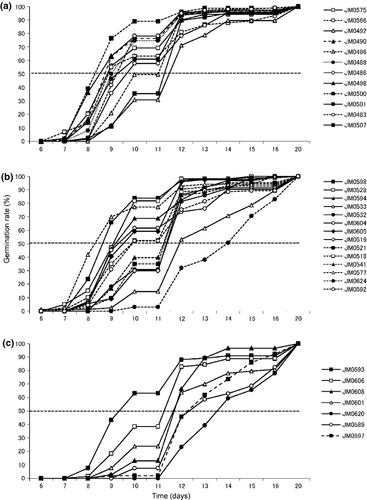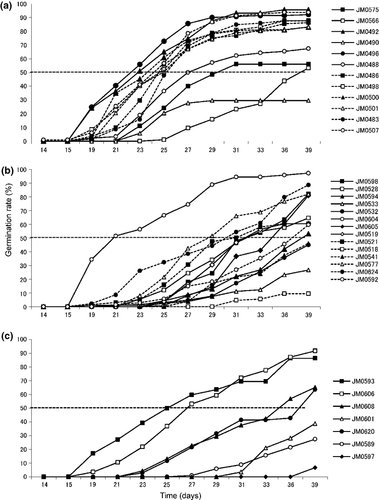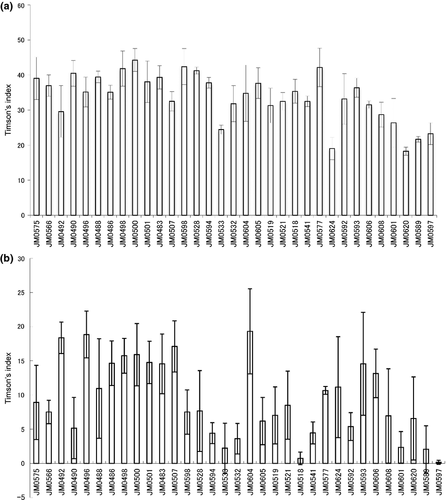Natural variation in Miscanthus sinensis seed germination under low temperatures
Abstract
Species within the genus Miscanthus show potential as sustainable bioenergy crops given their low nutrient requirements and high biomass yields. One such species, Miscanthus sinensis, has a wide natural distribution and wide phenotypic variation, including its seed germination characteristics. Such characteristics need to be considered, particularly in ensuring plant establishment in regions with harsh winters. Germination rates were measured for 33 M. sinensis accessions from different latitudinal regions in Japan. Generally, seeds of accessions from regions of higher latitude germinate earlier than those from more southerly regions under both warm (30°C/20°C day/night) and cool temperature (15°C/10°C day/night) treatments. However, accessions that had lighter seeds germinated late regardless of origin. This survey serves as a basis for identifying M. sinensis accessions that are able to germinate early under low-temperature conditions.
Introduction
Increasing demand for alternative and sustainable sources of energy has driven research into the development of non-food perennial bioenergy crops. The genus Miscanthus contains perennial grass species that have low nutrient requirements for production, high biomass yields, and the ability to sequester carbon (Lewandowski et al. 2003; Stewart et al. 2009; Sacks et al. 2013). Within the genus, Miscanthus ×giganteus, a sterile triploid hybrid generated from a cross between tetraploid Miscanthus sacchariflorus and diploid Miscanthus sinensis, exhibits agronomic traits that make it a leading contender for bioenergy crop production. However, due to its sterile nature, M. ×giganteus can only be clonally propagated, either through rhizome division or tissue culture (Clifton-Brown et al. 2011). The cost of clonal propagation exceeds that of seed propagation (Christian et al. 2005; Clifton-Brown et al. 2011). In addition, M. ×giganteus has very limited genetic variation, with only one hybrid widely cultivated and three new hybrids recently found among wild populations in Japan (Nishiwaki et al. 2011).
Given the limitations associated with M. ×giganteus, M. sinensis should be further evaluated as a potential bioenergy crop. M. sinensis is the most broadly distributed species of the genus Miscanthus in Asia, but one of its primary centers of diversity is in Japan (Sacks et al. 2013). Several M. sinensis lines have shown superior establishment and yield in colder climates at higher latitudes compared to M. ×giganteus (Jørgensen 1997; Farrell et al. 2006), which suggests it could serve as an alternative to M. ×giganteus in high latitudinal regions. As M. sinensis can be seed propagated, field establishment costs could be considerably lower than that of M. ×giganteus (Christian et al. 2005; Stewart et al. 2009; Clifton-Brown et al. 2011).
One essential requirement for successful perennial plant establishment in higher latitudinal regions is ensuring for early and vigorous seed germination under low temperatures to maximize plant growth before the onset of winter. Previous research has shown that M. sinensis seeds had the highest germination under a temperature regime of 30°C day/20°C night (Aso 1976). However, germination was delayed obviously under lower temperatures, and the time required to achieve 50% germination at low temperatures varied among M. sinensis half-sib families (Clifton-Brown et al. 2011).
Germination rate and thermal requirement for germination at low temperatures may also differ among M. sinensis germplasm collected from different latitudinal regions. Specifically, seeds from more northern regions were expected to germinate earlier than those from more southern populations. To test these hypotheses, we measured germination rates of 33 M. sinensis accessions collected across a latitudinal gradient ranging from 26.2° N in Okinawa to 40.9° N in northern Honshu in the Japanese Archipelago. We also investigated the effects of geographic origin and annual accumulation of degree-days of collection sites and seed weight on seed germination rate.
Materials and methods
Plant materials
Seed germination tests were performed on 33 M. sinensis accessions collected from various wild populations that were grouped into northern Japan (12 accessions), central Japan (14 accessions) and southern Japan (7 accessions) by latitudes (Supplemental Table 1). The seeds were collected from wild populations in autumn 2010, and stored at 4°C before being used in this study. Geographic coordinates for each location were recorded. Annual accumulation of degree-day temperature was generated from 30-year normalized temperature data (1981–2010) from the Japan Meteorological Agency's weather stations near to the collection sites. Threshold temperature was set at 5°C. For seed weight measurement, 300 seeds were randomly chosen from each accession and divided into three replications. Awn and callus hair were removed prior to measurements.
| Germination rate (Timson's index) correlated with | |||
|---|---|---|---|
| Latitude of origin | Seed weight | Cumulative temperature | |
| 30°C/20°C | 0.601** | 0.277 | 0.579** |
| 15°C/10°C | 0.495** | 0.458* | 0.497** |
- *P < 0.05; **P < 0.01 (Zar 1972).
Seed germination condition and observation
Germination tests were carried out under two conditions, a warm-temperature (30/20°C day/night, 12/12 h light/dark cycle) and cool-temperature treatments (15°C/10°C day/night, 12/12 h light/dark cycle). Both germination tests were performed using a LH-350S growth chamber (NK system, Osaka, Japan). For both tests, 150 seeds of each accession were randomly assigned into three Petri plates containing two layers of moistened filter paper. Plates were randomly rotated regularly inside the growth chamber to avoid positional effects on seed germination. Plates were watered as needed. For the warm temperature treatment, germinated seeds were counted every day for 16 days, with one final count at day 20. Seed germination occurred when 2 mm of radicle emerged from the seed. In the cool-temperature treatment, germinated seeds were counted every 2 or 3 days over a 39-day period. Seed germination was determined as described above. After 39 days, temperature was increased to warmer conditions (30°C/20°C day/night). Total number of viable seeds was calculated as the sum of germinated seeds over the cold and warm periods.
Data analysis
Germination rate was calculated as the number of germinated seeds divided by the total number of seeds. Fungi-infested or dead seeds were not included in total seed calculation. Seed germination rate was calculated using a modified version of Timson's index (Timson 1965; Baskin and Baskin 1998; Wang et al. 2008). This index is described as Σn/t, where n is the cumulative germination percentage for each observation day of the study and t is the germination period. For the warm temperature treatment Timson's index was calculated using t = 20 days, whereas for the cold treatment, Timson's index was calculated using t = 39 days. The non-parametric Spearman-rank correlation was used to calculate correlation between the Timson's index, seed weight, latitude and thermal time. Accessions were ranked as follows: highest Timson's index to lowest Timson's index, highest latitude to lowest latitude, heaviest seed to lightest seed, lowest cumulative degree-day temperature to highest cumulative degree-day temperature.
Results and discussion
The ability to germinate seeds under lower temperatures is one of the requirements to ensure Miscanthus establishment as a bioenergy crop in cooler regions. Germination of M. sinensis seeds was delayed under cool temperature (Figures 1-3). Most M. sinensis accessions from northern Japan germinated earlier compared to those from southern Japan (Figures 1, 2), which suggests that northern accessions may be more suitable for establishment in colder environments. However, under cool temperature, the accession JM0490 from Akita displayed delayed germination relative to other northern Japanese accessions. This may be associated with the relatively low seed weight of JM0490 compared to other northern accessions (Table S1). Indeed, accessions with lower seed weight displayed later seed germination as was observed by Aso (1976) for M. sinensis. Further analysis is needed to confirm the seed weight and the delayed germination. Germination rate is also associated with cumulative degree-day temperature (Table 1).



Germination under low temperatures also showed large variation between seed replicates compared to germination under warm temperature treatment (Figure 3). A similar phenomenon has been observed in oilseed rape (Squire et al. 1997). Squire et al. (1997) compared seed germination under conditions of 5°C between the two progenies from seeds germinated at 5°C and seeds that did not, but were able to germinate under normal temperatures. The offspring of the germinating seeds were found to germinate earlier than those that could not germinate at 5°C, suggesting that genetic variation in seed lots can influence germination at low temperatures in oilseed rape. Application of progeny test using selected materials from our M. sinensis accessions will confirm the genetic effects on low-temperature germination rate.
In conclusion, this study shows that germination of M. sinensis seeds is associated with the latitudinal location and annual degree-day accumulation at the collection sites of the M. sinensis accessions. Crossing M. sinensis accessions that are able to germinate early under low temperature with accessions that display rapid growth with high biomass yields could result in the development of M. sinensis new cultivars suitable for cultivation in regions with harsh winters.
Acknowledgements
Funding was provided by a grant from the Energy Biosciences Institute and the Ministry of Agriculture, Forestry and Fisheries, Japan. We gratefully acknowledge Professor John A. Juvik, Department of Crop Science, University of Illinois at Urbana-Champaign for careful and critical review of this manuscript and Ms Kumi Green and Ms Maiko Ohta for technical assistance.




